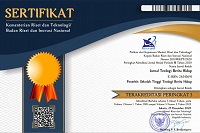Perananan Dianoia di dalam Kekudusan Ditinjau dari 1 Petrus 1:13-16
DOI:
https://doi.org/10.38189/jtbh.v3i2.85Keywords:
hope, obedience, διανοία, holiness.Abstract
Holiness is a familiar topic for Christians, of course. Even among believers today, churches usually emphasize holiness only in terms of morals, ethics, and good works. So it is not surprising that behind what appears on the outside, often the life of a believer hides heinous sins. Even the lives of servants of God, pastors, and church leaders are not immune from hidden corruption. A priest who is 50 years old, can molest a minor for years without being caught. This was even done under the guise of being a servant of God where the victim at that time became a student or child under the suspect's supervision. Seeing the reality of life like this, the writer believes that holiness cannot be seen as merely an external morality, but there is something deeper at play in it. Previous literature has attempted to explain what holiness is. This research tries to find the importance of διανοία in holiness by using the exegetical method, namely the interpretation of the verse by verse on the letter of 1 Peter 1: 13-16. By seeing the existence of διανοία (mind) which mainly contributes to holiness which then transforms one's actions to become holy. So the author took the wrong example of the text in 1 Peter 1: 13-16. The author analyzes the text and produces four points: first, διανοίας fully hopes on the grace of God. second, tighten διανοίας. Third, διανοίας is not indulgent. Fourth, Result of διανοίας. From the four points, the writer will explain how important διανοίας is in holiness.
References
Aruan, Tiopan, dan Hendi Hendi. “Konsep Manusia Baru di dalam Kristus berdasarkan Surat Efesus 4:17-32.†Evangelikal: Jurnal Teologi Injili dan Pembinaan Warga Jemaat 4, no. 1 (2020): 113–130.
Byantoro, Daniel. Pengantar Pertama kepada Philokalia. Bogor: Padepokan Dharma Tuhu, n.d.
Graham, Billy. Damai dengan Allah. Jakarta: Yayasan Komunikasi Bina Kasih / OMF, 1993.
Guthrie, Donald, Alec Motyer, Alan M. Stibbs, dan Donald J. Wiseman. Tafsiran Alkitab Masa Kini 3: Matius-Wahyu. Jakarta: Yayasan Komunikasi Bina Kasih / OMF, 2006.
Hakh, Samuel Benyamin. “Kuduslah Kamu Sebab Aku Kudus (Petrus 1:16).†Jurnal Teologi Sola Experientia 2, no. 2 (2014): 124–143.
Hendi. Formasi Rohani: Fondasi, Purifikasi, & Deifikasi. Yogyakarta: Leutikaprio, 2018.
———. Inspirasi Kalbu. Yogyakarta: Leutikaprio, 2017.
———. Inspirasi Kalbu 3. Yogyakarta: Leutikaprio, 2019.
Hendi, Hendi, dan Syelin Umur. “Strategi Pelayanan Pastoral bagi Kaum Awam menurut Bapa Gereja Gregorius Agung.†Fidei: Jurnal Teologi Sistematika dan Pratika 3, no. 1 (2020): 37–61.
Henry, Matthew. “Matthew Henry Commentary.†BibleWorks ver 10, n.d.
Mahrus, M. “Oknum Pendeta Tersangka Pencabulan Anak Ditangkap saat Hendak ke LN.†Radar Surabaya. Last modified 2020. Diakses November 30, 2020. https://radarsurabaya.jawapos.com/read/2020/03/09/182861/oknum-pendeta-tersangka-pencabulan-anak-ditangkap-saat-hendak-ke-ln.
Nikodimos, St., dan Isaac the Syrian. The Philokalia Volume Two. London: Faber and Faber, 1981.
Ryle, J.C. Aspek-aspek Kekudusan. Surabaya: Momentum, 2003.
Santo, Joseph Christ. “Strategi Menulis Jurnal Ilmiah Teologis Hasil Eksegesis.†In Strategi Menulis Jurnal untuk Ilmu Teologi, 121–139. Semarang: Golden Gate Publishing, 2020.
Subekti, T. Kesucian. Yogyakarta: Andi Offset, 1985.
Sumiwi, Asih Rachmani Endang. “Pembaharuan Pikiran Pengikut Kristus Menurut Roma 12:2.†Jurnal Teologi Berita Hidup 1, no. 1 (2018): 46–55. www.e-journal.iaidalwa.ac.id/index.php/jbh.
———. “Peran Roh Kudus dalam Kehidupan Orang Percaya Masa Kini.†Jurnal Teologi El-Shadday 1, no. 1 (2016): 55–68.


.jpg)







